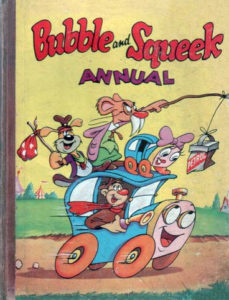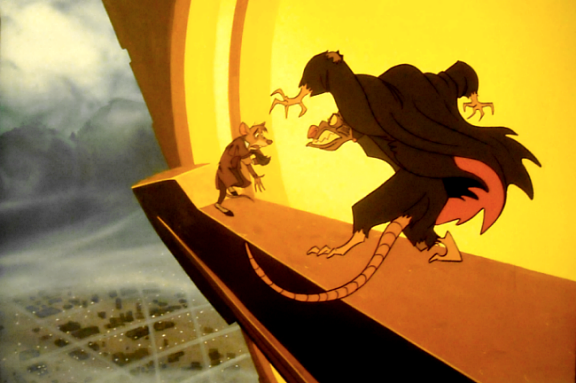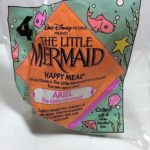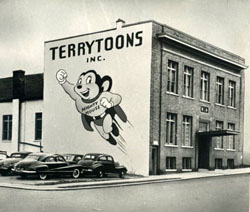 Bubble and Squeek. George Moreno Jr. was an American animator who worked for Universal/Lantz before joining the Fleischer Studio in Miami, Florida in 1938-40 as one of the animators on the feature-length Gulliver’s Travels (1939) and on shorter cartoons such as Way Back When a Nag was only a Horse (1940), Way Back when a Nightclub was a Stick (1940) and Ants in the Plants (1940).
Bubble and Squeek. George Moreno Jr. was an American animator who worked for Universal/Lantz before joining the Fleischer Studio in Miami, Florida in 1938-40 as one of the animators on the feature-length Gulliver’s Travels (1939) and on shorter cartoons such as Way Back When a Nag was only a Horse (1940), Way Back when a Nightclub was a Stick (1940) and Ants in the Plants (1940).
During the war he became friends with Richard Smith and showed him two characters Moreno had developed: Bubble, a cockney taxi driver, and his faithful cab, Squeek. The names were a take-off on a British dish called ‘Bubble and Squeak’ of pan-fried lefovers usually potato, cabbage and some mixed vegetables or meat.
With Smith, Moreno developed an animated studio, British Animated Productions. The first color cartoon was made in two rooms in Smith’s Walthamstow office. The unit later moved into an old button factory at Harringay. The company collapsed quickly when wartime restrictions on foreign products were lifted and the market was instantly flooded with American-made cartoons.
The Bubble and Squeek cartoons included The Big City (1947), Fun Fair (1947), The Old Manor House (1948), and Home Sweet Home (1948).
One of the characters in the cartoons, Colonel Rat, a monocled rodent, was spun off into a solo appearance in another cartoon Loch Ness Legend (1948). Moreno went on to work in television and commercial animation but the Bubble and Squeek characters appeared in some British picture annuals illustrated by Moreno and written by Arthur Groom.
Amongst the animators working on these cartoons were Harold Mack, Pamela French, Jimmy Holt, Leslie Boyd, Fred Thompson and Hugh Gladwish. Moreno mentored Frank Terry who animated on the series and later ended up teaching at CalArts.
Here is a two minute excerpt from 1948 newsreel on the making of a Bubble and Squeek cartoon from British Pathe:
Great Mouse Finale. In the October 1986 issue of American Cinematrographer magazine, director Burny Mattinson talked about the finale in Disney’s animated feature The Great Mouse Detective (1986): “We started out with Matthew O’Callaghan’s story sketches,” remembered Mattinson. “We always knew from the beginning, we were going to end up on the face of Big Ben somehow. Originally we were going to have the mice hold onto indidivual balloons, but then we got the idea for the dirigible. Once we crahsed through the face, it opened up a whole new idea: ‘Well, gee, what’s inside there?’
“That gained interest, so we did a few exploratory sketches and one thing led to another. None of it was pre-conceived. There was a lot more dialogue originally. Basil and Ratigan played a verbal trivial pursuit game with each other which became too talkly and slowed the scene down.

“We thought, wouldn’t it be nice to move up through these gears and feel like we were adding some dimension to them? Once we thought of the gears, the next question was ‘Who’s going to animate them?’”
The two minute fight scene was in an area containing 54 moving gears, winches, ratchets, beams and pulleys and they were drawn using computers. Directing animator Phil Nibbelink and Tad Gielow, a specialist in computer programming, spent months designing the blueprints for the interior of Big Ben. The computer drew vector lines of the moving gears on printout paper which were then copied by machine onto clear acetate animation cels and painted in the normal fashion. Some of the lines had to be re-inked.
The paper printouts were three-holed punched for animation peg registration so that animators could draw the characters in conjunction with the camera moves and keep the perspective in sync.
 John Musker on Little Mermaid. At a 1989 Minneapolis/St. Paul press event hyping the release of The Little Mermaid (1989), director John Musker said, “The Hans Christian Andersen ending was just too intense. We learned a lesson working of The Black Cauldron (1985) that even if a film is beautifully animated, people will not like it if it is too dark. And we also learned that part of the modern success of an animated film, something that Disney failed to do fully with The Great Mouse Detective (1986), is tie-in merchandising. I think from a management standpoint, they green-lit this film at least in part because of the feeling a fairy tale would be in line with a certain Disney legacy.”
John Musker on Little Mermaid. At a 1989 Minneapolis/St. Paul press event hyping the release of The Little Mermaid (1989), director John Musker said, “The Hans Christian Andersen ending was just too intense. We learned a lesson working of The Black Cauldron (1985) that even if a film is beautifully animated, people will not like it if it is too dark. And we also learned that part of the modern success of an animated film, something that Disney failed to do fully with The Great Mouse Detective (1986), is tie-in merchandising. I think from a management standpoint, they green-lit this film at least in part because of the feeling a fairy tale would be in line with a certain Disney legacy.”
 Terrytoons Retrospective. In the Daily News, February 7, 1982, there was an article about a New York retrospective of Terrytoons (focused at the New Rochelle Public Library) where the organizers located almost one hundred former Terrytooners through contacting former employees they knew who knew others and pored through old Christmas card lists to get names.
Terrytoons Retrospective. In the Daily News, February 7, 1982, there was an article about a New York retrospective of Terrytoons (focused at the New Rochelle Public Library) where the organizers located almost one hundred former Terrytooners through contacting former employees they knew who knew others and pored through old Christmas card lists to get names.
“I had marvelous times there at Terrytoons,” said Jim Gentiella. “I loved the magic of it. One day you’re drawing a picture and the next day they’re moving around.”
Eli Bauer said, “It was great working with and learning from the wonderful old-timers who worked there. Terrytoons has not been properly recognized for its contributions to the art of animation. Terrytoons covered the entire gamut from the early silent days to sound, to color, to television. Terry himself said that Disney was the Tiffany’s in the business and he was Woolworth’s. However, the animation done at Terrytoons is something that does great credit to Paul Terry, New Rochelle and the entire East Coast.”
 Snow Queen. The animated movie The Snow Queen (1957) featured a print advertisement with popular television host Art Linkletter proclaiming, “Hi! This is Art Linkletter telling you about a delightful new movie…FOR KIDS OF ALL AGES! It’s as gay as a diamond-studded rainbow! Filled with a world of wonders….from the secret of the Enchanted Mirror to the delights of the Snow Queen’s palace…and music to make your heart dance…A REAL TREAT FOR THE WHOLE FAMILY!”
Snow Queen. The animated movie The Snow Queen (1957) featured a print advertisement with popular television host Art Linkletter proclaiming, “Hi! This is Art Linkletter telling you about a delightful new movie…FOR KIDS OF ALL AGES! It’s as gay as a diamond-studded rainbow! Filled with a world of wonders….from the secret of the Enchanted Mirror to the delights of the Snow Queen’s palace…and music to make your heart dance…A REAL TREAT FOR THE WHOLE FAMILY!”
Based on the Hans Christian Andersen tale, this was a Russian film from Soyuzmultfilm in Moscow, directed by Lev Atamanov and redubbed into English in 1959 with the voices of June Foray, Paul Frees, Sandra Dee, Tommy Kirk and Patty McCormack. It was released by Universal and included a six minute live action introduction with Linkletter. It was later redubbed again in the 1998 with the voices of Kathleen Turner, Kirsten Dunst (replacing Sandra Dee) and Mickey Rooney (replacing Paul Frees). Fyodor Khitruk was one of the animators.
Hayao Miyazaki has stated that this film is one of his inspirations to work in animation and the original version won several awards including first prize in the animated film category at the 1958 Cannes Film Festival.


 Jim Korkis is an internationally respected animation historian who in recent years has devoted his attention to the many worlds of Disney. He was a columnist for a variety of animation magazines. With his former writing partner, John Cawley, he authored several animation related books including The Encyclopedia of Cartoon Superstars, How to Create Animation, Cartoon Confidential and Get Animated’s Animation Art Buyer’s Guide. He taught animation classes at the Disney Institute in Florida as well as instructing classes on acting and animation history for Disney Feature Animation: Florida.
Jim Korkis is an internationally respected animation historian who in recent years has devoted his attention to the many worlds of Disney. He was a columnist for a variety of animation magazines. With his former writing partner, John Cawley, he authored several animation related books including The Encyclopedia of Cartoon Superstars, How to Create Animation, Cartoon Confidential and Get Animated’s Animation Art Buyer’s Guide. He taught animation classes at the Disney Institute in Florida as well as instructing classes on acting and animation history for Disney Feature Animation: Florida.




















































“Gay as a diamond studded rainbow”…a film blurb decades ahead of its time.
Yes, Terrytoons did seem to be low-rent at the time. They lacked the humor of Warner Bros toons and the superior animation of Disney. But wouldn’t it be nice to examine these cartoons now and gain a new perspective and maybe appreciation. I guess DVDs are dinosaurs- like me.
I remember attending that Terrytoons retrospective at the New Rochelle Public Library. There were lots of great displays of cels and background art. A good deal of it was in rather battered condition, and I understood that much of it had been rescued from Dumpsters behind the studio after it had closed down.
Bubble & Squeak, for those who don’t know, is an English dish featuring leftover cabbage and potatoes, all fried up. Better than it sounds!
My niece loved Disney’s Mermaid. My clueless sister was in a video store and saw a non-Disney Little Mermaid for rent and brought it home. It had the original Hans Christian Andersen ending (the mermaid dies and becomes the foam in the sea) and my sister had to spend the night comforting her sobbing daughter.
Hey Jim, I found this cartoon that was produced by George Moreno Jr. titled, “Bubble and Squeek presets the Colonel and Willie (the Worm) Loch Ness Legend.” Is it part of the Bubble and Squeek series?
https://www.youtube.com/watch?v=F5gosaC07aA
EDITOR’S NOTE: Jim made mention of this cartoon, “Loch Ness Legend,” in his post above.
Thank you for the history on The Bubble & Squeek Cartoons, which I only recently heard of. Sad that even the U.K’s indigenous animation could not survive against Hollywood imports.
I do love they way they continually explain or reenact the animation process to this day for audiences. That wasn’t a storyboard. It looked as though they needed one on short notice and pinned a bunch of cel set-ups from the finished film. It was funny how he goes to draw Bubble shooting himself…..Thinks and thinks, acts it out in front of a mirror….and it looks exactly like the cel set-up.
The “Making Of..” clip was actually made more than a year after “Funfair” had been completed. Moreno made the first “Bubble & Squeek” film (“Big City”) ‘on spec’ while trying to get a distribution deal (for a proposed 6 films). What neither he nor his backers appreciated was that British exhibitors had found during the thirties that including cartoons in a programme did not have any significant affect on box office takings. Hence cartoons were only occasionally included. Further more, US cartoons, having already made back their costs at home, could be offered at a low rental by importing distributors – which forced the distributors of UK cartoons to keep rentals relatively low in order to compete. Even Britain’s longest-serving entertainment cartoon producer, Anson Dyer, had to admit it was not possible to make money from entertainment cartoons in the UK – only the Advertising market was prepared to pay for animation, which is why UK animation developed the way it did. By the 1940s the principal outlet for cartoons was in the News Theatres, which had increased in number during the War.
Moreno still could not get a distribution deal after completion of “Big City”, but he pressed ahead with the second film (“Funfair”) regardless, and it was completed in June 1947. British Lion agreed to distribute “Big City” as a favour, but were not interested in the series. Grimly determined, Moreno set to work on the third film, “The Old Manor House”.
After many months of tortuous negotiation Moreno finally achieved a distribution deal with Pathé in the autumn of 1948. To promote the series, Pathé filmed the “Making Of…” item for inclusion in its weekly Newsreel. (They actually released “The Old Manor House” first, on 29 October 1948, to allow for the newsreel item, issued 15 November 1948, to appear concurrently with the release of “Funfair” on 11 November. Hence the use of finished artwork to dummy up the storyboard! It is also worth noting that the artwork is all punched for the 2-pin registration system (and Harold Mack is using a 2-pin drawing board) when the studio had actually switched over to the Acme 3-pin system (which had become commercially available after the War) in the summer of 1948..
Regarding Frank Terry it is unlikely that he worked on “Bubble & Squeek” as he only 10 in 1949. Rather than being mentored by George Moreno I’ve read elsewhere that he was mentored by Harold Mack. Mack left Britain in the 50s to settle in Holland, and I suspect that Terry worked for him there.
(See http://s200354603.websitehome.co.uk/personnel/HMack.htm for more info on Harold Mack.)
Yep, all those Bubble and Squeek cartoons (sourced from a very, very, very dodgy VHS compilation from Loonic Video) were posted on YouTube by yours truly.
In the first installment, we discover the genesis of their relationship – Bubble is Squeek’s proud papa. How does a human father a car? Better not to ask.
The original 1959 redubbing and editing for U.S. release of “The Snow Queen” was supervised by Dave Fleischer, who Universal sent around the country to various cities as part of the promotion of the film
My DVD wish list, animated relics edition (excluding the stuff Thunderbean is already working on, God bless them):
— A decent print of “The Snow Queen”
— “Johnny the Giant Killer”, complete
— HB’s “Rock Odyssey”
— Jiri Trnka’s “A Midsummer’s Night Dreams”; also his fairy tale shorts
— The director’s completed version of “The King and the Sweep”
— “The Mouse and His Child”
— Various Russian fairy tales that were cut into serials for American kid shows
— “I Go Pogo”
— “Tom and Jerry Festival of Fun” (As I understand it, they edited shorts into a framing story ala the Disneyland TV show)
— Richard Williams’s version of “Thief and the Cobbler”
— “Raggedy Ann” — the Williams feature and the Fleischer two-reeler
Don’t forget the Li’l Abners and Fleischer’s “The Raven.”
Fred Thompson was my father. He remarried and moved to Kinsale,Ireland but continued to paint. He passed away around 2000.
The Moreno cartoons were fairly common in older 16mm rental catalogs (1950’s and 60’s.) Someone must have picked up the US 16mm rights. I’m guessing Sterling Films (Saul Turell and Paul Killiam) as they were always searching for foreign product they could get on the cheap.